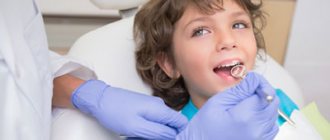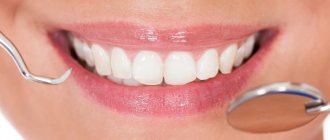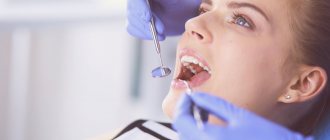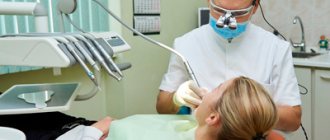“The child’s molar is loose. What to do? Is it possible to cure it at home? - these are typical questions often discussed in specialized sections of popular women's forums. Dentists never cease to be amazed at the recommendations that, in such cases, are given by more “experienced” forum users. Some advise not to worry and wait until the baby teeth are completely replaced with molars. Others recommend not to disturb the tooth again, not to loosen the tooth, and to switch your son or daughter to soft food “so that it doesn’t hurt.” Fortunately, the only correct advice is quite common - to take the heir to a pediatric dentist, who will understand the causes of the problem, prescribe and carry out adequate treatment.
“A new tooth is shaking” is really not always a reason to panic
During the period of change of bite, which starts at the age of 5–6 years, children's baby teeth begin to loosen. Following this, permanent ones appear who will have to faithfully serve the matured child throughout his life. The process of eruption of molars has its own characteristics.
- First, the dental crown appears, and the root that holds it in the jaw bone remains incompletely formed at this point.
- Therefore, for some time (usually no more than a year), a molar that is not firmly fixed can actually wobble slightly, and then it will strengthen naturally.
By the way, it is useful for adult dental patients to know that normally all permanent teeth have so-called physiological mobility. Our teeth are fixed in the bone alveolus with the help of a ligamentous apparatus, periodontium. Periodontal tissues perform shock-absorbing functions, evenly distributing the mechanical chewing load over the entire dentition and preventing the destruction of individual teeth under the influence of fairly serious chewing pressure. Few non-specialists know that with the help of the chewing muscles, our jaws can develop a force of up to 300–400 kg, depending on the consistency of the chewed products.
But if a mother notices that a child of 8–10 years old has a permanent tooth loose, the mobility is pronounced and accompanied by pain, the gums are swollen, and the child is also capricious and refuses to eat, it is necessary to urgently go for a consultation to pediatric dentistry. It is better to play it safe and exclude pathological mobility in order to prevent the possibility of premature loss of a tooth.
If there is no tooth, but the others are loose. What should I do?
In this case, we can use removable dentures made from individual impressions. The missing tooth will be covered with an artificial crown.
Pros:
- a removable denture will preserve diction;
- restore the child’s chewing, bite and self-esteem;
- getting used to it will happen very quickly.
The choice of design and material depends on the specific situation. For some injuries, this is the only possible option while the healing process is underway.
Typical causes of loose molars in children
- In the process of natural replacement of temporary teeth with permanent ones, mobile, restless children often injure their faces. A strong blow to the jaw can damage the surrounding soft tissues and lead to dislocation and fracture of the tooth. The damaged tooth will become mobile.
- In children, during a change in bite, inflammatory processes often occur in the oral cavity - in particular, gingivitis, inflammation of the gums.
- Only erupted molars are particularly susceptible to acid-forming bacteria. Quite often, carious cavities form in places that are difficult to access and are detected only when the child’s molar is already loose.
- Recently, children often have weak, loose gums. If hygiene is insufficient, they are easily affected by pathogenic bacteria and become inflamed. Periodontitis that occurs in children leads to loosening of teeth.
- The cause of the problem can also be diseases of internal organs caused by pathological metabolic processes and impaired blood supply.
- The genetic factor also plays a certain role. Cases of premature loss of healthy teeth that often occur in families may indicate an inherited predisposition to insufficient fixation of dental roots in bone tissue.
Factors such as poor nutrition, decreased immunity, abnormal bite, bruxism, and, during puberty, hormonal changes also increase risks.
Results
Based on all of the above, we realized that it is thanks to baby teeth that children develop a correct bite and set the right course for the development of permanent teeth. This fact suggests that there is no need to remove the first teeth in advance. If the tooth begins to loosen on its own, then in this situation you just need to help the baby get rid of it by eating solid food. But you should resort to the help of professionals only when the baby cannot cope with its problem on its own, or when the second one is already pecked under the first tooth.
We should also not forget about the rules of daily oral hygiene and timely visits to the dentist. These two conditions will help keep children's teeth healthy.
Health to you, your children and their teeth!
Treatment of caries in children - prevention of loose teeth
The enamel of newly erupted permanent teeth is incomplete and continues to form over several years, so it is easily damaged by pathogenic microflora. Even with an almost imperceptible defect on the surface of the tooth, the looser dental tissues located under the layer of hard enamel will be affected very quickly.
The attending physician will assess the degree of destruction of dental tissues and decide on the possibility of treatment. If you do not postpone your visit to the clinic, as a rule, there is no need to resort to tooth extraction in your child. Modern dentistry has effective materials and technologies that allow high-quality restoration of a damaged tooth. In addition to filling with high-quality photocomposites, inserts and crowns are used that retain the ability to fully chew food.
What to do after removing a baby tooth
The procedure itself for removing baby teeth is not complicated. However, in order to avoid the development of possible consequences after the removal of a baby tooth, you should follow the following medical recommendations:
- Do not eat or drink for two hours after removal
- Do not eat hot or cold food for two days
- Do not visit the pool or sauna for three days
- Use a soft toothbrush when brushing your teeth
- Do not apply compresses
- Do not rinse your mouth unless your doctor prescribes it.
- Consult a doctor if your body temperature rises above 38 degrees
After a tooth is removed, a blood clot forms at the wound site. It cannot be injured, otherwise it will take a long and painful time to heal. If the wound is bleeding: make a cushion from a sterile bandage, apply it to the removal site and have the child press it with his teeth. If bleeding cannot be stopped within 30 minutes, consult a doctor immediately.
Possible complications
Dry socket, or alveolitis, is the most common complication after tooth extraction, when a blood clot necessary for rapid and favorable wound healing does not form in the socket. Symptoms of alveolitis are: pain in the gums at the site of the extracted tooth, gray plaque in the wound. If alveolitis is not treated in time, it can lead to more serious consequences – osteomyelitis. Therefore, at the first signs of the disease, do not self-medicate, but immediately contact a specialist. The doctor will quickly make a diagnosis, carry out the necessary antiseptic treatment, and prescribe the necessary treatment.
How are gingivitis and periodontitis treated in a child?
Inflammatory diseases of the gum tissue can very quickly lead to loosening of permanent teeth. Therefore, it is so important not to miss the early symptoms of periodontitis in children - first of all, swelling of the gums and the appearance of blood when brushing teeth and eating solid foods.
The main cause of the development of inflammatory diseases is soft plaque, which remains due to poor quality teeth cleaning. Over time, it hardens, forming supra- and subgingival tartar. Hard periodontal deposits first cause inflammation of the mucous membrane, then the process covers periodontal tissue and bone tissue. “Dissolved” tissues no longer fix the permanent tooth, and it becomes loose. If treatment is not started, the child's teeth will fall out.
In some children, periodontitis may be caused by a lack of blood supply to the tissues. This usually occurs in the absence of the necessary chewing load. Parents should ensure that their children eat enough solid vegetables and fruits. In addition, it is necessary to bite and chew food not on one side of the dentition, but on both. In this case, the load on the teeth will be distributed evenly.
Treatment of gums begins with the removal of soft plaque and tartar, for which professional teeth cleaning for children is performed. Anti-inflammatory therapy is then prescribed according to the severity of the disease. In some cases, splinting of teeth is indicated - a procedure that prevents their further loosening. At the clinic, the child will be taught how to brush his teeth correctly, and the parents’ task will be to carefully monitor hygiene procedures at home and, if necessary, brush their son or daughter’s teeth.
Experts' opinion
According to research conducted by Irina Vladimirovna Klimova, Ph.D., Associate Professor of the Department of Pediatric Dentistry at Novosibirsk State Medical University, the Asepta treatment and prophylactic line of products has a pronounced hygienic, anti-inflammatory, and hemostatic effect in periodontal diseases in children and adolescents.
The use of an integrated approach and consistency in the selection of drugs from this line of products has demonstrated an improvement in clinical indicators and confirmed high efficiency in the treatment of periodontal pathology in children of different ages. The proposed treatment regimen using the Asepta therapeutic and prophylactic series of products can be recommended to pediatric dentists in the complex treatment of inflammatory diseases of periodontal tissue in children and adolescents.
Oral hygiene with a loose tooth
Prevention of childhood caries is so important that its importance cannot be overestimated. This applies not only to indigenous, but also to temporary units. The health of permanent incisors and molars depends on the condition of temporary chewing organs. Therefore, dentists recommend carefully treating the oral cavity of babies. By the age of two, you should visit the dentist for the first time for a preventive examination.
Children's crowns have soft, unformed tissue, so they are very sensitive and vulnerable. Care involves cleaning incisors and molars twice a day. When temporary units become loose and fall out, the gum tissue can become inflamed. Therefore, you need to use high-quality children's toothpaste to gently treat your mouth. Such products are suitable for thin enamel; they prevent caries and do not contain abrasives or fluoride.
Even with mobile units, hygiene procedures must be carried out twice a day to prevent the development of bacteria. Do not touch or pull the organ with dirty hands. If a baby brush does not remove food debris, it should be flossed. This procedure must be done by the mother. It is good if parents encourage their children to be responsible for cleaning their mouths.
What affects early or late eruption?
- Gender of the child. According to statistics, in girls the process of changing their bite begins earlier than in boys.
- If the baby gets sick quite often or suffered serious illnesses in early childhood, molars may begin to appear later.
- Specifics of the diet.
- How long was the baby breastfed?
- Composition of drinking water.
- Complications during pregnancy.
- Diseases of the endocrine system.
If a child loses a baby tooth at the age of 5, this is not a cause for concern, because all children are individual. The task of parents is to control the process of changing the bite and prevent the development of complications.
When is removal necessary?
There are relative and absolute indications. This, for example, is a highly carious lesion that leaves no chance of cure. Another reason is that the process of eruption of a permanent tooth has already begun when the milk tooth has not fallen out. Various diseases have absolute indications: fistulas on the gums, cysts on the roots, severe forms of pulpitis, periodontitis, etc.
Relative indications are the need to remove a loose tooth, which for some reason cannot fall out on its own, causes discomfort, and can cause inflammation of the gums.
Early loss of milk units
Some factors can trigger premature loss:
- Injuries resulting from falls or impacts.
- Abnormal bite. Particularly dangerous is the so-called deep bite, which increases the risk of losing lower units.
- Incorrect growth of teeth in a row.
- The neglected state of temporary units, which simply crumble as a result of carious lesions. Caries can affect either part of a tooth or several units.
If your child is 5 years old and his baby teeth are falling out, there is no need to panic. But to make sure everything is in order, you can show your child to the dentist.











